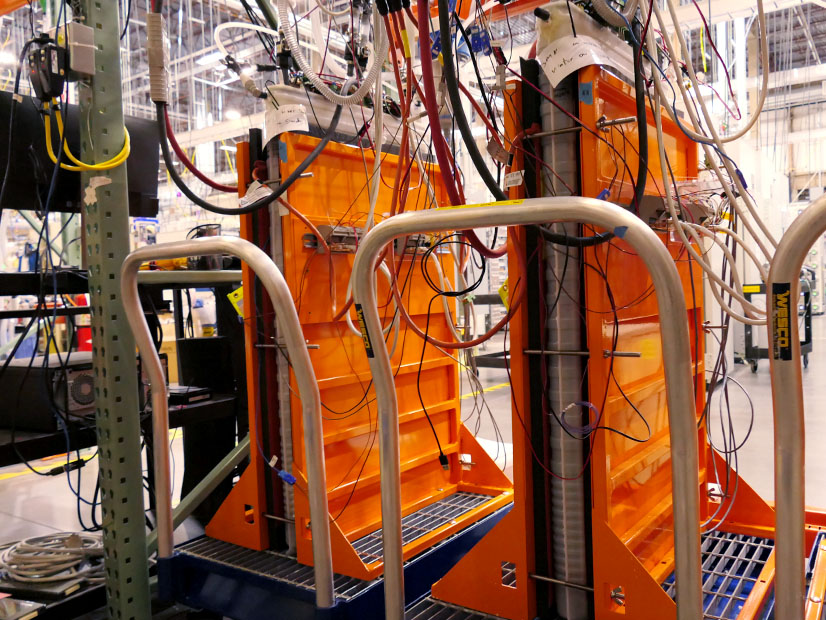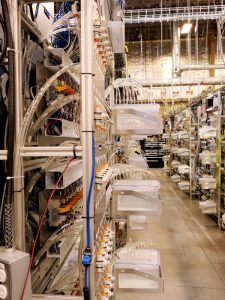When FERC convened the New England Winter Gas-Electric Forum in Portland, Maine, in June of this year, the commissioners grilled ISO-NE executives, government officials and company representatives about how they will meet the impending electricity demand from electrification. (See NE Stakeholders Debate Future of Everett at FERC Winter Gas-Elec Forum.)
As weather-dependent renewables replace legacy fossil fuel units, how will the region ensure it has enough power during extended winter periods when the wind dies down and there is little sunlight to draw upon?
While others highlighted the uncertainty associated with predicting the future resource mix past 2030, Richard Paglia of the gas pipeline company Enbridge was quick to point to a simple solution: more natural gas.
“To me, the glue that holds all of this together [is] the gas plants that are highly dispatchable and can solve that problem,” Paglia said. “But we don’t have the supply to allow those plants to run when needed.”
In September, Enbridge followed up on its prescribed solution and announced a project to significantly expand the capacity of the Algonquin gas pipeline into New England, which the company hopes to complete by the end of 2029. (See Enbridge Announces Project to Increase Northeast Pipeline Capacity.)
But this solution would not come without major tradeoffs: Five of the six New England states have set strong decarbonization goals, and natural gas is one of the major sources of carbon emissions and air pollution in the region. Meanwhile, climate and environmental justice groups have vowed to fight the expansion and hold climate-focused politicians to their rhetoric.
At the same time, early-stage clean energy companies are scrambling to address this energy reliability gap, hoping to fill the firm generation role that has historically been dominated by fossil fuel resources.
Form Energy, a company started in 2017 and headquartered in the city of Somerville, Mass., is developing long-duration iron-air batteries that it hopes to pair with renewable energy to firm up that generation across extended stretches.
Form’s batteries are built to provide 100 hours of energy and charge by converting rust to iron, a process that is reversed when discharging to produce electricity.
“The technology is quite ready,” Marco Ferrara, Form’s co-founder and senior vice president of analytics and software, told RTO Insider. While the company has made significant scientific advances in getting high capacity out of the batteries, “the technology is inherently simple.”
Most current grid-scale batteries have comparatively short durations, sitting in the two- to four-hour range. The U.S. Department of Energy defines inter-day long-duration energy storage (LDES) as the ability to shift power 10 to 36 hours, and multiday LDES as shifting power for a period greater than 36 hours.
According to a DOE report on LDES released in March, the U.S. could need between 225 and 460 GW of LDES capacity to reach net-zero by 2050, which would require about $330 billion in capital investment.
The report found that LDES could replace the need for over 200 GW of new natural gas capacity by 2050, and that LDES reduced the need for natural gas in all modeled scenarios.
“Analysis shows that by 2050, net-zero pathways that deploy LDES result in $10 billion to $20 billion in annualized savings in operating costs and avoided capital expenditures compared to pathways that do not,” the DOE report concluded. To achieve this, LDES deployment capacity must reach 10 to 15 GW per year by 2030 and 30 GW per year by 2040, the report found.
Form does not have any utility-scale batteries in operation but has several pilot and demonstration projects in the pipeline. The company is currently developing a 1.5-MW pilot project with Great River in Minnesota, two 10-MW projects with Xcel Energy in Minnesota and Colorado, a 5-MW project with Dominion Energy in Virginia, a 10-MW project with the New York State Energy Research and Development Authority and a 15-MW project with Georgia Power. The expected in-service dates range from 2024 to 2026.
The two projects with Xcel will be located at the sites of two retiring coal plants, chosen in part because of the ability to charge the project with nearby renewable power, existing water-supply infrastructure and the ability to upgrade grid interconnection infrastructure.
The company performs most of its research and development in its Somerville lab, where engineers test all sorts of variables in thousands of battery cells lined up in long rows, separated by grocery store-style aisles.
While the company does not have any projects in development for New England, it sees great potential for the technology in the region. A white paper published by the company in late September found that by adding 23 GW of multiday storage capacity by 2050, the New England grid would see a 33% reduction in the cost of eliminating fossil fuel generation and reduce clean energy curtailment by 83% compared to a scenario with no multiday storage.
“Pairing sufficient multiday storage with offshore wind can create a firm zero-carbon energy resource that would support grid reliability during all times of the year for a cost that is 80% less than with short-duration storage,” the report found.
The study modeled the grid during all days of the year under different weather scenarios. Ferrara emphasized that modeling weather and load across all hours of the year, instead of short representative stretches, is essential to understanding the true reliability attributes of a resource.
“Methodology matters,” Ferrara said. “If you solve a capacity expansion problem with that richness of information, you come up with a portfolio that is truly robust across weather years.”
Along with portfolio planning methodologies, Ferrara highlighted several key challenges to scaling up Form’s technology. He said the company’s ability to rapidly increase manufacturing would likely be the limiting factor as it works to meet growing demand.
“We don’t see any particular blockers on the supply side; we see a lot of opportunity on the demand side for our technology; and we’re there in the middle,” Ferrara said, noting the relative availability of the battery’s key components: iron, water and air. The company is fast-tracking construction on a large manufacturing facility in Weirton, W.Va., and is hoping to begin operations at some point in 2024.
Ferrara also pointed to the need for appropriate compensation mechanisms to account for the grid benefits that long-duration storage could provide. At a meeting of ISO-NE’s Consumer Liaison Group in June, a Form representative said the company is interested in bringing projects to the region but is limited by the RTO’s current market structure. (See Activists Want ISO-NE to Push for Renewables.)
Currently, ISO-NE does not differentiate between short-term and long-term battery storage systems in its capacity accreditation system, although the RTO is working to change this dynamic in its ongoing Resource Capacity Accreditation (RCA) project.
“Determining how to account for the reliability attributes of storage systems, which have different sizes, durations, etc., is a major component of the RCA project,” an ISO-NE spokesperson told RTO Insider in a statement. They added that while the region currently relies on stored fuels like oil and LNG when other resources are not available, “in light of the ongoing clean energy transition, it is clear that the region will need to explore alternative resources to provide these essential services.”
ISO-NE’s 21-day energy simulator — used to study future resource adequacy — only models two-hour batteries and pumped hydro. The RTO denied stakeholder requests earlier this year to look at long-duration storage in its Operational Impacts of Extreme Weather study, saying that developing a tool to model this could not be completed to fit the timeline of the study.
The inability to study a wider range of storage durations “is problematic for system modeling and transmission planning, where energy storage can act as a transmission-enhancing technology, as well as for the [alternative resource] sector’s larger goals of seeing energy storage markets advance in ISO-NE,” said Alex Lawton of Advanced Energy United, a clean energy association whose membership includes Form Energy and other storage types.
In future analyses, ISO-NE said it plans to continue improving its modeling capabilities, including adding the ability to model long-duration and multiday storage.
FERC recently approved an ISO-NE proposal to allow energy storage to serve as transmission-only assets to solve transmission issues. These new rules will allow batteries to function as transmission assets for the first time, but they impose strict limits on their use, including largely prohibiting them from participating in the RTO’s markets and limiting their total capacity on the grid to 300 MW. (See FERC Accepts ISO-NE Filing to Allow Storage as a Tx-Only Asset.)
In a filing prior to the commission’s ruling, United called the changes a “first step” while recommending that the RTO develop guardrails to allow transmission-only storage assets to participate in ISO-NE markets and consider lifting the capacity limits as it gains operational experience with them.
As the region sits on the precipice of major new investments in fossil fuel generation and infrastructure, Ferrara said he hopes ISO-NE considers investing in and incentivizing zero-emission reliability solutions like long-duration and multiday storage. He advocated for reforming the capacity markets to account for differences in storage durations, as well as the establishment of a “zero-carbon capacity product.”
In January, Massachusetts released a proposal for a forward clean energy market (FCEM), which included a “clean capacity certificate” product aimed at incentivizing non-emitting capacity resources. However, this proposal has failed to gain traction with the other New England states.
ISO-NE has indicated that it is up to the states whether to pursue an FCEM, telling RTO Insider that “the New England states have communicated that they are not interested in pursuing this market design at this time. As a result, we have not conducted further analysis.”
A spokesperson for Massachusetts’ Executive Agency of Energy and Environmental Affairs told RTO Insider that the state is “committed to exploring new long-durational energy storage technologies that not only could reduce our dependence on the grid and our carbon footprint, but also offer savings for residents and businesses.”
With the dual challenge of impending state decarbonization targets and electricity demand increases, Ferrara said it is important to start developing projects in the region as soon as possible. He noted that the company’s white paper found that the least-cost 2030 storage portfolio to prevent outages would include about 3 GW of multiday storage.
“If we’re really serious about goals in 2040 and 2050, and we’re building assets that last 20 years, we need to build them now,” Ferrara said.



